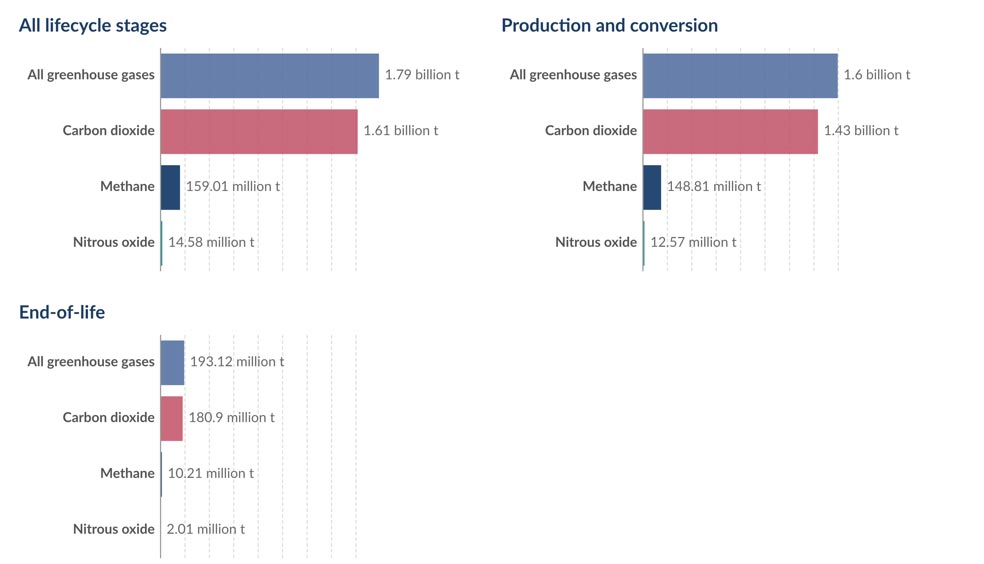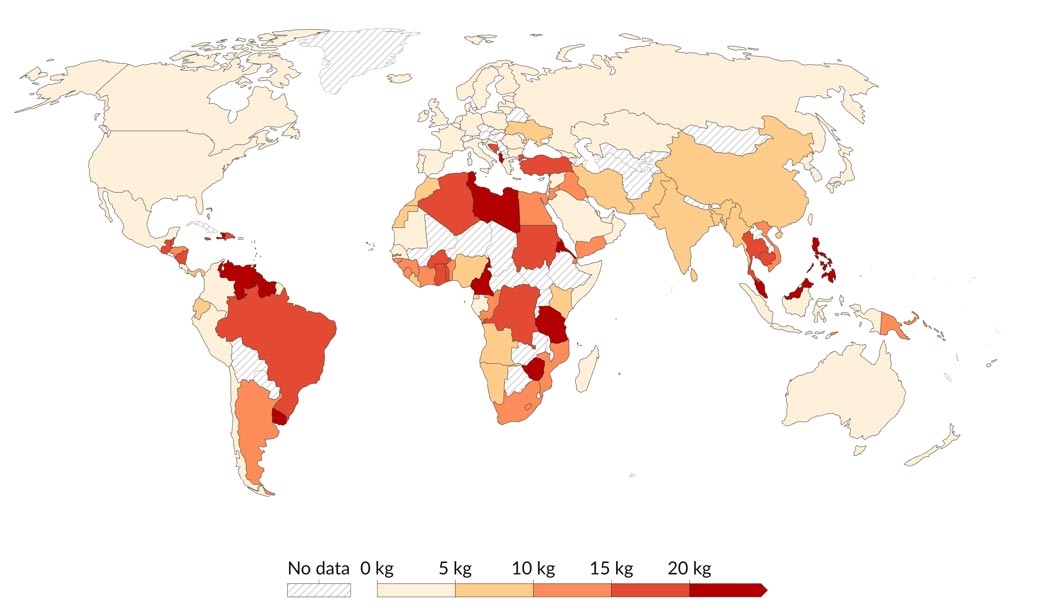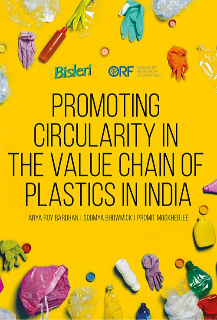Executive Summary
|
The social cost of the plastics industry in India is estimated at US$62 - 96 billion for the year 2023.
(The social cost includes the market price of plastic, emissions cost involved in the production process, and the mismanagement costs of plastic wastes.)
The present value of the social cost of continuing a business-as-usual structure in the plastics industry for the period 2025-2030 is US$541 billion.
The present value of the social cost of adopting a 100-percent circular plastic value chain by 2030 is estimated at US$370 billion.
|
| The net present value of benefits that will accrue by implementing 100-percent circularity by 2030 is US$170 billion. |
| Present benefit of circularity=Present cost of inaction=US$170 billion |
The study undertakes a quantitative analysis of the value chain of plastics in India to estimate the social benefits that can be generated from adopting a circular framework.
| Circularity Benefit |
US$170.47 billion |
| (i.e. US$170 + billion in social costs can be avoided by adopting circularity) |
The study also conducted an alternate scenario analysis, where the degree of circularity in 2030 is varied to emphasise the need for urgent implementation.
| Degree of Circularity in 2030 |
Net Present Value of Benefit over BAU framework (in US$ billion) |
| 50 percent |
28.6 |
| 75 percent |
31.8 |
| 100 percent |
33.6 |
The report also looks at the current structure of the plastics market in India, and especially at the management of plastic waste. It discusses the regulatory frameworks that are in place and makes policy recommendations to facilitate a greater degree of circularity in the sector. The following are some of the key takeaways from this study:
- The use of plastics globally has soared twenty-fold in the past 50 years and is expected to double in the next 20 years due to its benefits like durability and flexibility.
- According to a mean-difference test, advanced nations tend to export more plastics than developing nations and contribute more to global plastic pollution.
- In India, a significant portion of plastic waste is not properly managed. The requirement is a circular economy roadmap that will include recycling solutions.
- The pollution generated by India's plastics industry continues to worsen as India stands among the top five global polluters, producing around 4 million tonnes of plastic waste annually.
- Of the 8,300 million tonnes of polymers, synthetic fibres, and additives produced globally from 1950 to 2015, 55 percent ended up in landfills, 8 percent were incinerated, and only 6 percent were recycled.
- The global trade in plastic waste, often from developed to developing countries, contributes to environmental pollution and poses risks to the health and environment of receiving countries.
- Plastic consumption in India surged from 14 million tonnes in 2016-17 to 20 million tonnes in 2019-20, with Maharashtra, Gujarat, and Tamil Nadu accounting for 38 percent of the total waste in 2019-20.
- Plastic waste generation in India reached 4.1 million tonnes in 2020-21, nearly triple the volume in 2016-17; the primary sources are packaging, automotive, agriculture, and textiles.
- India's urban waste management struggles with the rising volume of plastic waste, achieving only around 85–86 percent collection efficiency in Municipal Solid Waste (MSW).
- Mismanaged plastic waste in India, especially during monsoons, poses risks to water systems, causing blockages and ocean pollution.
- India's 60-percent recycling rate for post-consumer plastic waste is largely due to the informal sector; municipalities, relying on basic recycling methods, contribute less to the recycling effort.
- India’s Plastic Waste Management Amendment Rules 2021 targets reducing pollution from single-use plastics by banning items like plastic cutlery and earbuds with plastic sticks.
- If replicated and scaled, proven effective circular practices in the global plastics sector present opportunities for sustainable development.
- Only 50 percent of plastic waste in India is recycled, with the rest contributing to environmental degradation and resulting in a significant social cost. Aiming for 100-percent plastic recycling could yield major economic benefits and align with the Sustainable Development Goals (SDGs).
- A case study is undertaken to highlight the need for aligning corporate responsibility with sustainability needs. Bisleri’s Bottles for Change initiative is discussed as a replicable framework for enhancing consumer awareness.[a]
- The report’s proposed actions include reducing production of non-recyclable plastics, improving recycling infrastructure, and formalising waste collection systems.
- Amid challenges in policy implementation, such as enforcing bans on single-use plastic and incentivising waste segregation, targeted capacity-building should be provided to small and medium enterprises (SMEs); other imperatives are investment in recycling infrastructure and innovation in end-of-life solutions for plastics.
Introduction
Plastic was once seen as a groundbreaking innovation whose advantages were many, among them its lightweight nature, flexibility, durability, and extended shelf-life. Over the past 50 years, there has been a twenty-fold increase in the usage of plastic, with expectations of doubling over the next two decades due to higher living standards that in turn encourage increased consumerism.[1] Today, however, the widespread and unabated use of plastic has become a massive environmental threat. Indeed, the positive aspects of plastic are offset by the unsustainable production processes and mismanagement of plastic waste, causing issues such as clogged drains, flooding, the breeding of disease-causing vectors, and adverse impacts on land and marine ecosystems.
The COVID-19 pandemic only increased the demand for plastic, as safety and hygiene requirements led to the mass production of commodities like personal protective equipment and packaging. The latter, accounting for 59 percent of Indian plastics consumption,[2] offers a parallel opportunity for a transition to a circular economy. At present, the linear model of plastic production contributes to global oil and gas consumption, and the downstream stage generates substantial volumes of single-use plastics that generate massive waste.[3] In India, despite recycling efforts, a considerable portion of plastic waste ends up mismanaged. This circularity roadmap aims to break the reliance on fossil feedstock, promote recycling, reduce plastic litter, and emphasise the need for recyclable and cost-effective alternatives. This roadmap highlights challenges in biomass availability, market development for recycled plastics, and technological limitations for eco-design. Implementation requires collaboration among governments, industry, academia, and the informal sector, and regular monitoring that will allow for course-correction should ensure optimal effectiveness.
- The Production-Consumption Menace
Plastics present a two-pronged problem: greenhouse gas emissions during production and use, and subsequent waste management challenges. The plastic industry's reliance on fossil fuels and the emissions associated with each step of the production process underscore the need for a transition to renewable energy and more sustainable production practices.
The pollution from the production of plastics is significant and multifaceted.[4] The processes involved—from the extraction of raw materials to the manufacture of the final products—contribute to a range of environmental pollutants, including greenhouse gases. During the extraction phase, the procurement of fossil fuels, which are the primary raw materials for plastic production, involves drilling and mining activities. These activities themselves are energy-intensive and release a considerable amount of carbon dioxide (CO2) and methane (CH4), both potent greenhouse gases, into the atmosphere.
Another major source of emissions is the refinement of crude oil and natural gas to produce ethylene, propylene, and other plastic precursors. These processes are carried out in petrochemical plants that are powered by burning fossil fuels, leading to the emission of CO2, sulphur oxides (SOx), nitrogen oxides (NOx), and other pollutants that contribute to air quality degradation and climate change. Furthermore, the polymerisation process, where small molecules are chemically bonded to form polymers, the building blocks of plastics, also requires energy, typically from the burning of fossil fuels.
Plastic production and disposal account for about 3 percent of global emissions, when measured in carbon dioxide equivalents which consider the varying warming impacts of different greenhouse gases. Fig. 1 summarises the emissions throughout the life cycle of plastics, from production to disposal. Ninety percent of these emissions come from the production phase.[5]
Figure 1: GHG Emissions from Plastics, 2019 (in tonnes of Carbon Dioxide Equivalent[b])

Source: Our World in Data, data from OECD (2022)[6]
Global plastic production has grown from 2 million tonnes in 1950 to over 450 million tonnes in 2019, highlighting the escalation in potential pollution sources.[7] This increase in production has not only led to more waste but also to a substantial rise in the carbon footprint of the plastics industry. Emissions from plastic could represent up to 13 percent of the remaining carbon budget by 2050, which is critical in the context of the 1.5-degree goal set by the Paris Agreement.[8]
To mitigate the environmental impact of plastic production, it is essential not only to improve waste management but to reduce production overall. At present, only 9 percent of the world's plastic waste is recycled, and half of it goes directly to landfills. Another fifth is mismanaged, either not being recycled or kept in sealed landfills; these then enter and pollute natural environments, including rivers, lakes, and oceans.[9] The remaining fifth is incinerated.
From 1950 to 2015, a total of 8,300 million tonnes of polymers, synthetic fibres, and additives were produced globally, with 55 percent ending up in landfills and 8 percent being incinerated; only 6 percent was recycled. Projections suggest that if current production and waste management trends persist, a staggering 12 thousand million tonnes of plastic waste could be generated by 2050.[10]
Historically, developed countries have produced more plastic waste per capita; however, it is the low- to middle-income countries that often see higher levels of mismanagement as they lack sufficient waste infrastructure. Middle-income countries contribute significant amounts of the total plastic waste that end up in the world’s water bodies (see Fig. 2).
Figure 2: Mismanaged Plastic Waste Per Capita, 2019 (in kg)[c]

Source: Our World in Data, using data from Meijer et al. (2021)[11]
A critical factor to consider is the export of plastic wastes which involves the international shipment of discarded plastic materials for recycling or disposal. This practice, which comprises a part of total global trade, is notable for its impact on global inequalities, as developed nations often export their plastic waste to developing countries. The export of plastic waste from affluent to impoverished nations brings about negative consequences, including global environmental pollution, particularly in developing countries, as wealthy nations contribute to widespread ocean plastics. This practice poses substantial health and environmental risks in the recipient nations, negatively impacting communities and ecosystems. Furthermore, allegations of illegal exports[d] reveal a lack of proper regulation and oversight, emphasising the need for more stringent controls.[12] This practice of industrialised nations disposing of substantial volumes of their waste by exporting them to poorer countries is referred to as "waste colonialism".[13]
Table 1: A Global Divergence Snapshot of Plastic Waste Exports
| A plastics exports (in kgs per capita) mean difference (between advanced and developing countries) test using the latest available data for 213 countries around the world (see Appendix A) yields statistically significant results at a 1 percent level of significance. The provided t-test compares the means of two independent samples—representing developing nations (Latin America and the Caribbean, East and Southeast Asia, and Sub-Saharan Africa) and advanced nations (Middle East and North Africa, Organisation for Economic Co-Operation and Development, Eastern Europe and Central Asia, and Oceania), assuming unequal variances between the two groups. The negative t-statistic (-3.57) indicates that the mean of developing nations is significantly lower than that of advanced nations. The p-values are extremely low (close to 0), suggesting strong evidence to reject the null hypothesis that the means are equal. Therefore, there is a statistically significant difference between the two groups. The t-statistic lies beyond the critical values for both one-tail and two-tail tests, further supporting the rejection of the null hypothesis. Advanced nations tend to export more plastics, conforming to a variant of the pollution-haven hypothesis, i.e., richer nations shift the cost of pollution to poorer nations. This is attributed to less stringent policies and lower institutional costs with respect to waste management in poorer nations. |
| Metrics |
Developing Nations |
Advanced Nations |
| |
|
|
| Mean |
1.07 |
4.64 |
| Variance |
6.49 |
78.01 |
| Observations |
131.00 |
82.00 |
| |
|
|
|
| |
|
|
| Hypothesised Mean Difference |
0.00 |
|
| df |
90.00 |
|
| t Stat |
-3.57 |
|
| P(T<=t) one-tail |
0.00 |
|
| t Critical one-tail |
2.37 |
|
| P(T<=t) two-tail |
0.00 |
|
| t Critical two-tail |
2.63 |
|
| |
|
|
Source: Authors’ own, using data from UN Comtrade[14]
The primary reasons for such exports include insufficient domestic recycling capacity, as seen in the case of the UK exporting a substantial portion of its plastic packaging in 2019 due to limited recycling capabilities.[15] European countries are struggling with effectively and sustainably managing increasing volumes of plastic waste. In early 2019, the EU’s plastic waste exports amounted to around 150,000 tonnes per month—a significant decrease from the monthly 2015–16 levels of 300,000 tonnes, primarily directed towards China and Hong Kong.[16] This decline could be attributed to import restrictions and a shift in exports to other Asian countries.
With plastic production and consumption on the rise, environmental issues are becoming more acute, and the inefficiency of waste management systems is a growing concern. These issues are prompting regulatory changes and shifting consumer behaviour, particularly regarding the pollution of marine environments. The push towards circular economy models in developing nations like India offers investment opportunities to address plastic pollution and its impacts.
The sustainable development agenda encompasses 17 Sustainable Development Goals (SDGs), which have motivated member states to commit to adapting their policies to meet specified objectives by 2030. However, the pressing issue of plastic pollution is notably absent from the explicit focus of the SDGs.
The concern about plastic pollution was first crystallised by the Honolulu Commitment of 2011, which primarily addressed plastic debris in the oceans. Only later was plastic pollution recognised to extend beyond the seas to freshwater, land, and air, posing threats to the environment as well as human health. This prompted discussions and actions around SDG 14 (Life Below Water). In July 2017, the United Nations adopted the resolution “Our Ocean, Our Future: A Call for Action”, urging all member countries to intensify efforts to prevent ocean pollution, with an emphasis on reducing single-use plastics (SUP) and single-use plastic packaging.[17]
However, addressing plastic pollution should not be confined to SDG 14 and needs a more holistic approach that integrates SDG 3 (Good Health and Well-Being), SDG 12 (Responsible Consumption and Production), SDG 13 (Climate Action), and SDG 15 (Life on Land). The international community must recognise the far-reaching implications of this issue to develop comprehensive, cross-cutting solutions that address the multifaceted nature of plastic pollution across various sectors and dimensions of sustainable development. For instance, additives used to make plastics industry-ready have severe health implications for both humans and animals; the minute nano plastics are poisonous and tend to penetrate organ tissue, leading to varied physiological ailments.
In India, plastic consumption surged from 14 million tonnes in 2016–17 to 20 million tonnes in 2019–20, with a compounded annual growth rate of 10 percent. Maharashtra, Gujarat, and Tamil Nadu contributed significantly, accounting for 38 percent of total plastic waste output.[18]
Despite the size and impact of the plastics industry in India, the benefits of a circular value chain have not been quantified. Existing studies only discuss the regulatory frameworks needed for circularity and the benefits of adopting such frameworks. However, there is little literature that extends beyond the design and estimates the benefits of circularity or the present costs of inaction. This report aims to bridge the gap between theory and practice by estimating the net present benefit of implementing a 100-percent circular framework in the Indian plastics value chain. The report discusses the current structure of the plastics market in India and the existing policy frameworks that guide waste management. Additionally, the role of the informal sector in plastic waste management and the lack of infrastructure are discussed. Existing literature that discusses the state of circularity in India are examined. This report aims to serve as a guide to the contemporary structure of the plastics industry in India and makes key policy recommendations to ease the social burden of plastic waste.
This report analyses the plastics value chain in India. First, the business-as-usual (BAU) scenario is analysed to compute the costs of the plastics industry, which measures the social cost of plastic production per year based on multiple inputs derived from existing estimates. Second, a circularity framework is suggested where the 100-percent-circular plastic value chain goal is aligned with the 2030 Sustainable Development Agenda and recommends aiming for complete circularity by 2030. The net present value of adopting this framework is calculated over the 2025–30 period.[e] The report also presents the methodology and suggested framework as well as presenting the policy recommendations.
Read the entire report here.
The views expressed above belong to the author(s). ORF research and analyses now available on Telegram! Click here to access our curated content — blogs, longforms and interviews.

 PDF Download
PDF Download





 PREV
PREV




